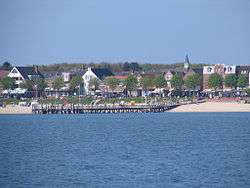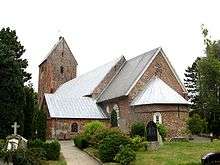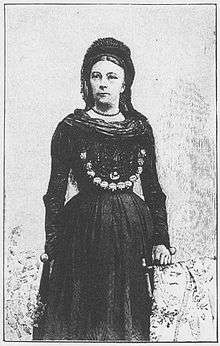Wyk auf Föhr
![]()
Wyk auf Föhr a Wik / Vyk | |
|---|---|
 Wyk's beach promenade as seen from the water | |
 Coat of arms | |
Location of Wyk auf Föhr a Wik / Vyk within Nordfriesland district | |
 Wyk auf Föhr a Wik / Vyk  Wyk auf Föhr a Wik / Vyk | |
| Coordinates: 54°42′N 8°34′E | |
| Country | Germany |
| State | Schleswig-Holstein |
| District | Nordfriesland |
| Municipal assoc. | Föhr-Amrum |
| Government | |
| • Mayor | Hans-Ulrich Hess (CSU) |
| Area | |
| • Total | 8 km2 (3 sq mi) |
| Elevation | 1 m (3 ft) |
| Population (2018-12-31)[1] | |
| • Total | 4,218 |
| • Density | 530/km2 (1,400/sq mi) |
| Time zone | CET/CEST (UTC+1/+2) |
| Postal codes | 25938 |
| Dialling codes | 04681 |
| Vehicle registration | NF |
| Website | www.wyk.de |
Geography
Wyk is situated on the southeastern edge of the island. About 4,500 inhabitants live there, but during the tourist seasons 20,000 or more people will stay there. It serves as a regional centre for the islands of Föhr and Amrum, providing shopping centres, doctors, a post office, etc. and it is the seat of the Amt Föhr-Amrum and the social care centre for the islands. The approximately 4,200 other inhabitants of Föhr proper live in other villages on the island. Wyk's major source of income is the tourism business.
History and tourism
In 1704, Wyk was granted the rights of a seaport, two years later, the rights of a market town were awarded. In 1819 a seaside spa was established, being the first of its kind in Schleswig-Holstein.
Thereby the state began to level up with the Baltic Sea region (Heiligendamm, 1794 and the East Frisian North Sea area (Norderney, 1794). In the first year, 61 guests were recorded, in 1820 there were 102, but only from 1840 on the numbers exceeded 200. From 1842 to 1847 the Danish king Christian VIII chose Wyk as his summer resort, which attracted numerous new tourists. In 1844 Hans Christian Andersen followed his king to Wyk and is known to have said about Wyk's beach: "I bathed every day and I must say it was the most remarkable water I have ever been in". But Andersen also criticized the problems of journeying there. For example, from Hamburg, on the road, a traveller needed four days to reach Föhr, by ship via Heligoland, it took two days only but included the danger of sickness.
.jpg)
In 1910 Wyk was granted full town rights.
Wyk's promenade Sandwall does not only offer a view on the sea, but also a view on the Halligen, already beloved by king Christian. It is counted among Germany's most beautiful seaside promenades.
Not at least due to the high number of sanitoriums and recovery institutions, Wyk is a highly frequented spa throughout the year.
In 2002 Wyk belonged to the ten most important centers of tourism in Schleswig-Holstein: 46,368 guests, 325 (0.7%) of which from foreign abroad, booked 492,041 overnight stays. The town had 4,733 beds to offer.
Sights



.jpg)
Inside Wyk's town limits, in the Olhörn area, there is a minor lighthouse. Frisian customs and the history of Wyk are documented at the Dr. Carl Haeberlin Museum, whose entrance portal is made up of two whale jaw bones.
The church of St. Nicolas is a roman style building from the 13th century, situated in the Boldixum town district. It has got a colourful and amply decorated interior.
Traffic
Wyk is the only harbour of Föhr, providing a ferry port, a fisheries and freight port and a marina. From the ferry port, several sailings per day are scheduled to the mainland port of Dagebüll while other ferries depart in the opposite direction towards the island of Amrum. Most ferries to Dagebüll have a train connection from there to Hamburg via Niebüll. The ferries are operated by Wyker Dampfschiffsreederei Föhr-Amrum GmbH whose seat is in Wyk. Other than scheduled ferrying, foray tours are offered to the Halligen of Langeneß and Hooge and in the summer season, passenger ferries sail to Hörnum on Sylt.
Wyk can moreover be reached by small planes via an airstrip, a daily flight schedule connects Föhr and Sylt during the summer season. Bus lines connect to the villages of the island.
Education
Wyk has a high school (Gymnasium), a Realschule with Hauptschule part, an elementary school including a special school and a Danish school. The town also hosts a branch of Nordfriesland's District School of Music.
Health care
A district hospital serves the population of Föhr and Amrum. Moreover, a number of sanitoriums are located in town, among them a clinic for oncology, an institution for mothers with children and several other private and public clinics. There is also an old people's home.
Politics
The local council has 17 members. Since the municipal elections of 2013, the distribution of seats in the town council is as follows:
- Kommunale Gemeinschaft(Local community): 5
- CDU: 5
- SPD: 4
- Green Party: 3
Arms
Blazon: Gules. On a base azure, wavy, a shipwrecked 17th century full rigged ship or, without sails and with broken tops. In chief a mullet of six rays or.
Motto: "Incertum quo fata ferunt". From Latin it translates roughly to "Uncertain (it) is where fate carries us".
Town twinning
Media
Wyk is the seat of the editorial office of the daily paper Der Insel-Bote.
Notable people
Born in Wyk

- Stine Andresen (1849–1927), poet
- Friedrich Christiansen (1879–1972), fighter pilot, nazi General
- Knud Broder Knudsen (1912–2000), politician
- Hans von Storch (born 1949), climate researcher and meteorologist
- Arfst Wagner (born 1954), Waldorf school teacher and editor
- Olaf Jürgen Schmidt (born 1981), German author and theater director
Affiliated with Föhr
- Sidonie Werner (1860–1932), politician. Founded a sanitorium for Jewish children endangered by tuberculosis (1927–1938) in Wyk.
- Carl Haeberlin (1870–1954), founder of the Frisian museum in Wyk and researcher of Frisian history; pioneer of thalassotherapy
- Hellmuth von Mücke (1881–1957), officer of the Imperial Navy, lived in Wyk 1929–1940
- Hans-Jürgen von Maydell (born 1932), silviculture scientist, graduated from high school in Wyk in 1954
- Heidrun Hesse (1951–2007), Professor of Philosophy, died in Wyk
- Stanfour, a rock band
Honorary citizens
- Ernst von Prittwitz und Gaffron (1833–1904), Prussian Lieutenant General and knight of the Order of St. John
References
- "Statistikamt Nord – Bevölkerung der Gemeinden in Schleswig-Holstein 4. Quartal 2018 (XLS-file)". Statistisches Amt für Hamburg und Schleswig-Holstein (in German).